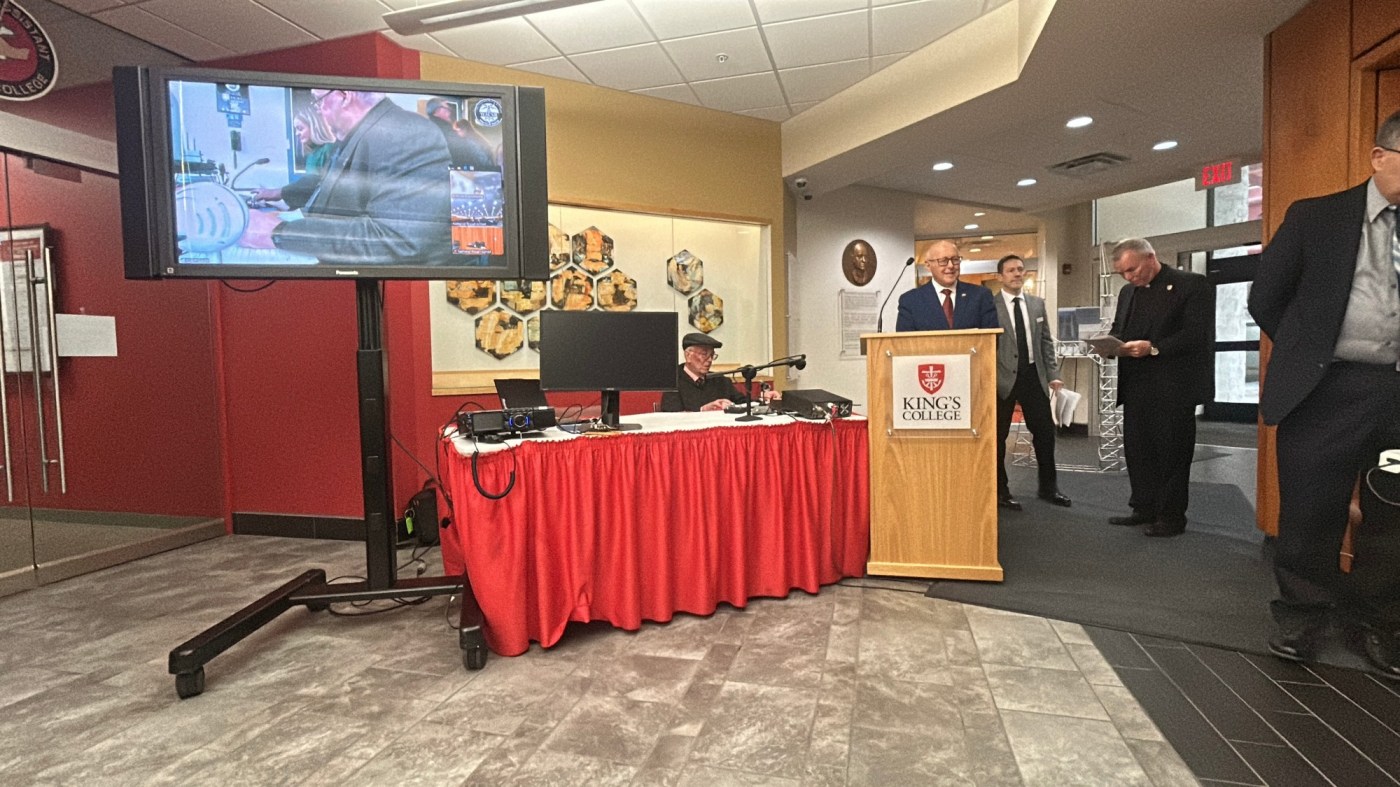Lifestyle
Mayors Recreate Historic Wireless Transmission for 120th Anniversary

The cities of Wilkes-Barre and Scranton commemorated a significant milestone on November 23, 2023, marking the 120th anniversary of the world’s first successful wireless telegraph conversation. The event featured a live re-enactment of a historic communication that took place on that date in 1905, showcasing the pioneering work of the Rev. Jozef Murgas.
During the celebration, Wilkes-Barre Mayor George Brown and Scranton Mayor Paige Cognetti connected wirelessly from their respective locations—20 miles apart—using Morse code. The original transmission, facilitated by Murgas’s groundbreaking technology, served as a testament to the advancements in communication that have since transformed the world.
Mayor Brown initiated the re-enactment from King’s College, delivering a message that echoed the words of former Wilkes-Barre Mayor Fred Kirkendall in 1905. He stated, “Wilkes-Barre and Father Murgas send their best wishes to you and to our healthy daughter, Miss Scranton. Since the last election, the wires of the machines have been cut, and we are sending you this without them.” The message was then transmitted using the characteristic beeps and buzzes of Morse code.
In response, Mayor Cognetti relayed the original reply from Scranton Mayor Alex Connell, expressing, “Scranton sends hearty congratulations to Father Murgas, our mother city’s foremost inventor. May he live long enough to derive all the benefits he is entitled to.”
Pioneering Technology and Lasting Legacy
The event took place outside the Father Joseph Murgas Room at the Richard Abbas Alley Center for Health Sciences, located near the site where Murgas conducted his innovative experiments. While Italian inventor Guglielmo Marconi is often credited with developing the first practical wireless telegraph system, many historians argue that Murgas was the true pioneer of wireless communication on land.
Murgas established a large antenna outside Sacred Heart Church in Wilkes-Barre, successfully transmitting messages via Morse code on November 23, 1905. His work challenged the prevailing notion that wireless transmission was only feasible over water. According to historian Michael Novroski, Marconi had claimed land-based wireless communication was impossible until Murgas proved otherwise.
The Navy recognized Murgas’s contributions as well. In August 1905, President Theodore Roosevelt secretly visited Murgas’s church laboratory during a trip to Wilkes-Barre, underscoring the significance of his work.
After years of research and patenting his inventions, Murgas, along with investors, constructed two 200-foot antenna towers in Wilkes-Barre and Scranton. Following the first successful transmission, the towers faced challenges, including severe storm damage and the passing of some initial investors. Ultimately, Murgas relinquished his pursuit of wireless telegraphy due to financial constraints and the dominance of Marconi, who had greater resources and government contracts.
A Multifaceted Life
Beyond his achievements in communication, Rev. Jozef Murgas was known for his diverse interests. He was not only a priest but also a painter, architect, botanist, and naturalist. Murgas registered a patent on an early fly-fishing reel and amassed a remarkable collection of 9,000 butterflies, one of the largest in North America.
Born in Slovakia in 1864, he emigrated to the United States after corresponding with a Slovak priest in Pittston. Murgas played a vital role in completing the construction of Sacred Heart Church in Wilkes-Barre’s Slovak neighborhood, where he later served as the parish priest until his death in May 1929. He was laid to rest in Sacred Heart Cemetery in Dallas, which he established during his time in the congregation.
Saturday’s event, organized by the Murgas Amateur Radio Club and the Slovak Heritage Society of Northeastern Pennsylvania, celebrated not only Murgas’s scientific achievements but also his enduring legacy within the community. As cities reflect on the past, the memory of the “radio priest” continues to inspire innovation in communication technology.
-

 Lifestyle4 months ago
Lifestyle4 months agoLibraries Challenge Rising E-Book Costs Amid Growing Demand
-

 Sports4 months ago
Sports4 months agoTyreek Hill Responds to Tua Tagovailoa’s Comments on Team Dynamics
-

 Sports4 months ago
Sports4 months agoLiverpool Secures Agreement to Sign Young Striker Will Wright
-

 Lifestyle4 months ago
Lifestyle4 months agoSave Your Split Tomatoes: Expert Tips for Gardeners
-

 Lifestyle4 months ago
Lifestyle4 months agoPrincess Beatrice’s Daughter Athena Joins Siblings at London Parade
-

 World4 months ago
World4 months agoWinter Storms Lash New South Wales with Snow, Flood Risks
-

 Science4 months ago
Science4 months agoTrump Administration Moves to Repeal Key Climate Regulation
-

 Science3 months ago
Science3 months agoSan Francisco Hosts Unique Contest to Identify “Performative Males”
-

 Business4 months ago
Business4 months agoSoFi Technologies Shares Slip 2% Following Insider Stock Sale
-

 Science4 months ago
Science4 months agoNew Tool Reveals Link Between Horse Coat Condition and Parasites
-

 Sports4 months ago
Sports4 months agoElon Musk Sculpture Travels From Utah to Yosemite National Park
-

 Science4 months ago
Science4 months agoNew Study Confirms Humans Transported Stonehenge Bluestones









